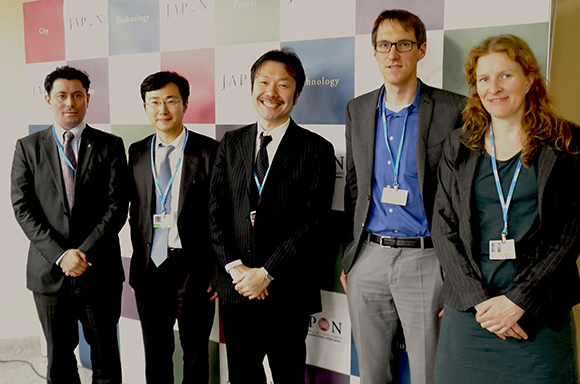Building International Cooperation for Low Carbon Technology Transfer
United Nations University Institute for the Advanced Study of Sustainability (UNU-IAS)
Outline
This side-event brings together several leading voices from academia and international organisations to look at the different dimensions of low-carbon technology transfer and ways international cooperation can enhance it. The session will showcase various activities in the area of cooperation on low-carbon technology transfer particularly in Japan, UK, France and Germany, and provide considerations for future directions post COP21.
Program
-
- Building International Cooperation for Low-carbon technology transfer
- Dr. Christopher Doll, Research Fellow, UNU-IAS
-
- How COP21 can shift the energy sector technology innovation onto a low-carbon path that supports economic growth and energy access
- Dr. Takashi Hattori, IEA
-
- Japanese Initiatives on low carbon technology transfer -L2-Tech and JCM-
- Dr. Kotaro Kawamata Counsellor, Embassy of Japan in Germany
-
- Insights from NAMA development in Peru: Developing an Enabling Environment and A finacial Mechanism to foster technology uptake
- Mr. Markus Hagemann, NewClimate Institute, Germany
-
- Discussion and Q&A
- Discussant: Dr. Heleen C. de Coninck, Radboud University Nijmegen
Summary
Building International Cooperation for Low-carbon technology transfer
Dr.Doll (UNU-IAS) opened the meeting with by introducing the United Nations University Institute for the Advanced Study of Sustainability and provided an overview of the Low Carbon Technology project which included its structure aims and activities for the year. He further outlined some of the current thinking in this area before finally introducing the participants.
How COP21 can shift the energy sector technology innovation onto a low-carbon path that supports economic growth and energy access
Dr.Hattori (IEA) made the first of the presentations. He provided an overview of the IEA's activities in multi-lateral technology cooperation with a focus on their technology roadmap studies noting that a future focus will be to get more indepth in what is happening regionally for certain technologies. He also advocated for greater R&D spending and greater cooperation with the private sector.
Japanese Initiatives on low carbon technology transfer -L2-Tech and JCM-
Dr.Kawamata (Embassy of Japan) followed with a presentation that outlined two major initiatives of the Japanese Government in the area of technology transfer, namely the L2 tech initiative and JCM. He noted that, in general, support for energy efficiency measures are not well captured in the UNFCCC processes (e.g. in the CDM).
Insights from NAMA development in Peru: Developing an Enabling Environment and A finacial Mechanism to foster technology uptake
Mr.Hagemann (New Climate Institute) gave the final presentation detailing work they had done regarding financial mechanisms that were evaluated in the case of a Peruvian biomass NAMA. This presentation focused more on how to build an enabling environment that supports technology transfer. He showed that different combinations of financing can make projects substantially more attractive.
Discussion and Q&A
Dr.de Coninck was then invited to provide a commentary on the discussions. In her comments, she highlighted the role of in-country capabilities and the need to let innovations happen locally. However she also noted that there was a gap in knowledge about the all the potential technologies that exist and also that technology transfer at some point goes from collaboration to competition and cautioned that it is important for UNFCCC to recognise this in their negotiations.
Key Messages
- Short term actions need to be complemented with long-term goals
- The technology around energy efficiency extends to many/wider areas than are currently appreciated including technology to support the energy management system
- Technology transfer is critically determined by enabling environments including financial attractiveness and absorptive capacity in the local market
- Public policies for low-carbon innovation are useful to provide the pull factor that matches a technology push
- There is a tension between competition and collaboration as ultimately we are dealing with firms that are competing in a global technology market
Photograph
Reporters
Hideyuki Mohri, United Nations University Institute for the Advanced Study of Sustainability





